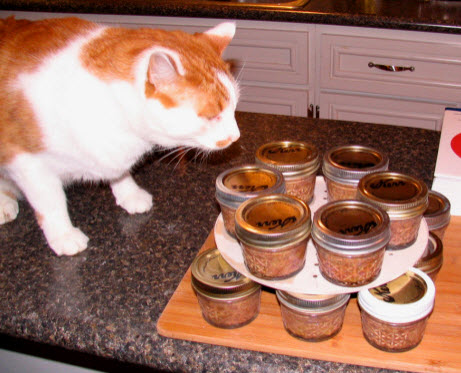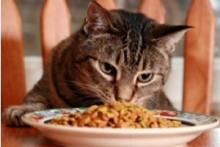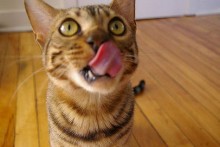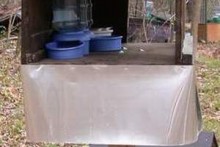DIY Canned Cat Food
Cook and can your own wet cat food! Select pieces of meat that your cat might enjoy, such as liver or other gizzards, and boil the meat until it is fully cooked. Put the cooked meat through a meat processor with a bit of wheat bread. Cook rice and add rice to the meat mixture. Pressure can the food into small jars and label the food.
Ingredients: meat, wheat bread and rice, as well as wheat germ oil and cod liver oil
Update: Our research has shown that this recipe needs to include additional ingredients, such as wheat germ oil and cod liver oil, in order to provide your cat with the necessary levels of vitamin E & D.






Again, there are supplements a cat needs to be healthy and live. This does not have them. If you can’t fix food for your cats that is healthy, please just buy food.
Dawn,
Thank you for bringing up this important point! Let’s calculate the amount of taurine in this dish. If chicken liver is used for this recipe, there is 1100 mg taurine per kg in the liver. If 80% of the taurine is lost to heat, that’s 220 mg taurine left per kg meat. If we assume that each jar is 4 oz and the mixture is 60% meat, then we can calculate that there is 15 mg taurine per jar. It is usually recommended that cats receive 2 cans of canned food per day, which would mean that this cat would get 30 mg taurine per day. That is 5 mg more than the 25 mg minimum required according to Dr. Pitcairn’s Complete Guide to Natural Health for Dogs and Cats, so this recipe should provide just enough.
As I mentioned on the DIY Cat Kibble post, it is also important to note that the ASPCA says that “due to the practice of over supplementation, hypervitaminosis—poisoning due to excess vitamins—is more common these days than hypovitaminosis, or vitamin deficiency! Excess vitamin A may result in bone and joint pain, brittle bones and dry skin. Excess vitamin D may result in very dense bones, soft tissue calcification and joint calcification.”
However, a recipe of only chicken liver, wheat bread, and rice, probably doesn’t contain all of the minimum vitamin requirements for a cat. The Dr. Foster and Smith chart of recommended vitamin dosages for cats is based on dry food, so those values cannot be used to calculate a wet food dish. However, those three ingredients contain little to no vitamin E or D, so it can be safely assumed that this food would be deficient in those vitamins. However, instead of adding supplements, consider adding a few more ingredients that have high amounts of the vitamins needed, such as wheat germ oil for the vitamin E, or cod liver oil for the vitamin D (as well as some omega 3 fatty acids).
Thank you again for inspiring this investigation Dawn! I’m sure that no one making a recipe for their pet intends to hurt their pet, however it’s always good to do your own research, especially when it comes to something as important as your health or the health of your pet.
Source: Dr. Pitcairn’s Complete Guide to Natural Health for Dogs and Cats
Source: Department of Molecular Biosciences, School of Veterinary Medicine, University of California – Taurine concentrations in animal feed ingredients; cooking influences taurine content
Source: Cat-World – Vitamin A Toxicosis in Cats
Source: ASPCA – Nutrients Your Cat Needs
Source: Dr. Foster and Smith – Fat Soluble Vitamins: A, D, E & K in Cats
Source: Healthaliciousness – Top 10 Foods Highest in Vitamin D
Source: United States Department of Agriculture – Basic Report: 04038, Oil, wheat germ
Source: United States Department of Agriculture – Basic Report: 04589, Fish oil, cod liver